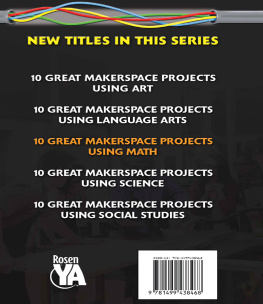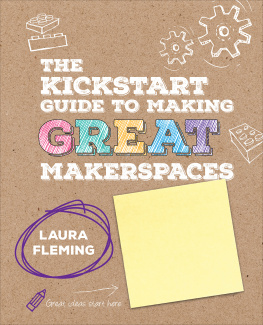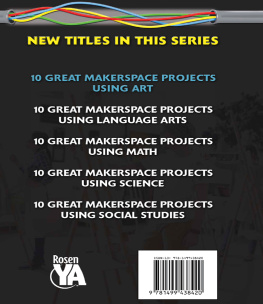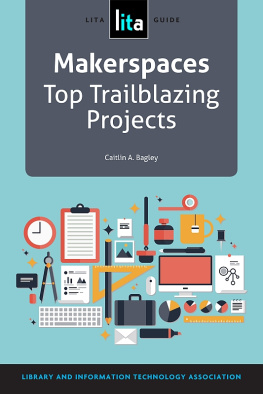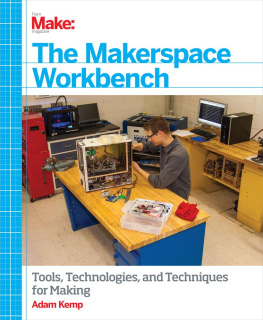Published in 2018 by The Rosen Publishing Group, Inc.
29 East 21st Street, New York, NY 10010
Copyright 2018 by The Rosen Publishing Group, Inc.
All rights reserved. No part of this book may be reproduced in any form without permission in writing from the publisher, except by a reviewer.
Names: Staley, Erin, author.
Title: 10 great makerspace projects using science / Erin Staley.
Description: New York City: Rosen Publishing, 2018. | Series: Using makerspaces for school projects | Includes bibliographical references and index. | Audience: Grade 612.
Subjects: LCSH: MakerspacesJuvenile literature. | ScienceStudy and teachingActivity programsJuvenile literature.
Some science projects focus on engineering while others are experimental and involve experiments.
S cience is everywherein the sports you play, the rainbow outside your window, and the mobile device you use to stay connected to the world at large. Science studies the world around us, asking who, what, when, where, why, and how. It explores function and reactionall in an effort to better understand why things work the way they do, and to solve pressing problems.
Science has two branches: life and physical. Biology, botany, and zoology are examples of life sciences. Astronomy, chemistry, and geology are examples of physical sciences. One of the best ways to explore any of these branches is to build a school project. This could be for fun, or it could fulfill a class assignment. Theres no better way to gain practical, hands-on experience than to create your school project in a makerspace.
Makerspaces are community-based workshops. They offer the safety, resources, and support to create anything from a pocket piano and robot to a smartphone microscope and articulated hand. Makerspaces are established in woodshops, auto shops, libraries, computer labs, and warehouses. They are found worldwide, and participation can be free or based on a paid membership.
Each makerspace is as unique as the do-it-yourself (DIY) users it serves. Participants include artists, hobbyists, teachers, students, entrepreneurs, and industry professionals. Although they may range in age and skill level, makers come together to explore project ideas, exchange know-how, and share designs. They also access a wide range of tools and equipment they wouldnt normally be able to use. Most makerspace have manual, power, and computer-controlled tools. Examples include hammers, saws, pliers, digital sewing machines, laser cutters, 3D printers, electronics, and metalworking equipment. How-to classes and workshops are often available. These teach beginning makers how to safely and effectively use the onsite equipment. Advanced classes dive deeper into detail and techniques. Makerspace amenities may include locker rooms, storage areas, a library of reference books, and display cases for finished projects.
Makerspaces encourage the blend of classroom knowledge and experimentation. Strategy, design, and the development of innovative solutions are all a part of the experience. In return, participants have fun creating, problem solving, moving beyond mistakes, and working with others. They learn how to think critically, manage time, and communicate effectively. New friends are made, and confidence soars. Plus, makers gain an impressive set of skills. These can open doors for higher education, a new career, or a money-making endeavor.
Every makerspace has an if you can dream it, you can build it mission. As you create, invent, and experiment, you will be well on your way to becoming an expert maker. And who knows, you may even develop a new method or technology to benefit the world around us.
CHAPTER ONE
LET THE SEWING BEGIN!
B ring artwork, fashion, and dcor to life with LEDs, sensors, and microcontrollers. Each reacts to changes in the environment, allowing craft and science to mesh in a single spectacular project. To help you create these special effects, you will need a makerspace sewing machine.
A WORLD OF OPPORTUNITY WITH DIGITAL SEWING MACHINES
Three types of sewing machines can be found in makerspaces: mechanical, electronic, and computerized. They vary in ability but offer a world of opportunities for textile projects. Mechanical sewing machines are equipped with the basics: dials, knobs, levers, and switches. They run on electricity and are user controlled by hand. The stitches are made quickly but are not as precise as those made on electronic or computerized sewing machines.
Electronic sewing machines are the next step up. They feature a liquid crystal display (LCD) screen. This allows the user to select various decorative and utility stitches. Buttonholes and alphabets can also be created, depending on the model. They offer greater precision than a mechanical sewing machine.
High-tech digital sewing machines use advanced technology and multiple functions to help makers create textile projects. They can handle denim, satin, corduroy, and polyester fabrics easily.
Computerized sewing machines use internal microprocessors to control the automatic sewing. Decorative and utility stitches, as well as patterns, are saved on memory cards or cartridges. Some machines connect to a computer with internet access, allowing users to download even more stitches and patterns. Once the preferred stitches and patterns are entered into the machine, it will automatically create the design.
Additional tools and equipment are used to for textile projects. Irons remove deep wrinkles. Steamers freshen garments, curtains, and upholstery. Sergers sew, trim, and finish seams at the same time. Leather punches create holes in belts, watch straps, shoes, and saddles. Seam rippers pull out unwanted seams and attachments. And wooden hoops hold fabric for needlecraft.
THE MATERIALS LIST
Sewing machines work best with flexible materials, such as muslin, cotton, felt, leather, vinyl, and yarn. They can be sewn together, knotted, quilted, repaired, or altered. Regular thread is a common binder. However, there are other, more exciting materials, that will enhance a sewing project. These include conductive thread, programmable LEDs, and sewable circuits.
SAFETY MATTERS
Exercise caution when using a sewing machine. They are generally safe, but their needles have been known to pierce the skin if used carelessly. Always unplug any unused equipment.
TYPES OF MAKERSPACES






